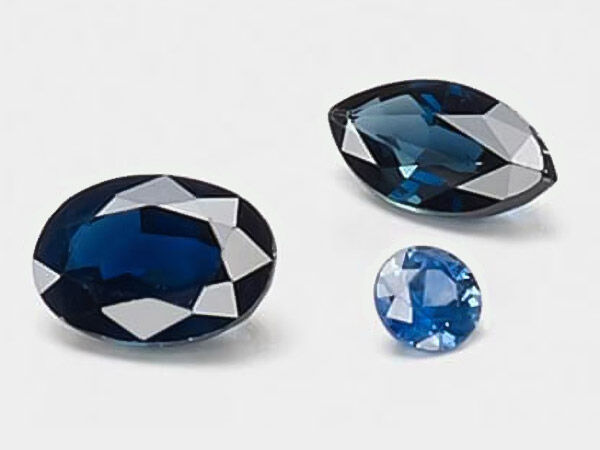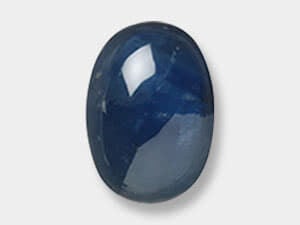Sapphire Meaning and Properties
Sapphire History
It wasn't until the Middle Ages that the word "sapphire" was used to describe the sapphire we know today. Before then, going back to antiquity, sapphire (from the Greek word for blue stone, σάπφειρος) was used to refer to lapis lazuli, another blue gemstone. The Greeks used sapphire to curry favor with the god Apollo and wore it while visiting the Oracle of Delphi. Sapphire is associated with Abraham in the Judeo-Christian tradition and was one of the twelve precious stones incorporated into the breastplate of the High Priest of Israel.
Since medieval times, sapphire properties have been associated with the majesty and tranquility of the heavens. Because they believed it symbolized heaven, clergy in the Middle Ages wore blue sapphires. Kings and queens wore it to attract wealth and for protection. It was thought by many to dispel evil thoughts and to bring peace and amiability to its wearer as well as ward off illness and overcome poisons.
Around 1800, sapphire and ruby gemstones were both classified as varieties of the mineral corundum . Because of that, the red of ruby is the only color not found in varieties of sapphire.
From the 15th century to the early 20th century, sapphire (along with diamond) was the birthstone for April. In 1912, an association of jewelers in the United States adopted a list of birthstones and made a few changes that included moving sapphire to become the birthstone for September. In the United States, sapphire has been the traditional and modern gift to commemorate a 45th wedding anniversary.
Although rare, some large sapphires are well-known, such as the "Star of India," "Midnight Star" and "Star of Asia," which are all star sapphires.
With a hardness rating of 9 on the Mohs scale, sapphire is also used for shatter-resistant windows, crystals in wristwatches and electronic circuitry including integrated circuits and LEDs.
Learn about this stone that's synonymous with wealth and royalty, get expert design tips from Patti, and see how to make sapphire jewelry in one quick step.

What are the Metaphysical Properties of Sapphire?
From antiquity, gemstones have been thought to possess mysterious powers. Sapphire is said to be the wisdom stone, stimulating concentration, enhancing creativity and promoting purity and depth of thought.
It is believed to focus and calm the mind as well as remove unwanted thoughts, depression and mental tension. It is known as the stone of new love and commitment and is claimed to be useful in encouraging faithfulness and loyalty. Sapphire properties are associated with peace of mind, serenity and prosperity.
Because of its blue color, it is associated with the throat and brow chakras where energy imbalances are said to cause sore throats, headaches and nightmares.
What is Sapphire Made From?
Sapphires and rubies are closely related, having corundum as their base mineral. The iron pigment in the corundum makes sapphire blue, while the chromium element in rubies makes them red. Corundum gemstones are the second hardest of the most precious of gemstones (diamond, sapphire, ruby, and emerald). Sapphire actually has a range of colors, from blue to yellow to green to orange-pink. Colorless sapphires are occasionally used as a substitute for diamonds in jewelry. Sapphires look best under natural light; under incandescent lighting, they tend to look dull and unsaturated.
Sapphire is mined from alluvial or weathering deposits, rarely from primary rock. It is mined primarily in the United States, Australia, China, Thailand, India, Kenya and Nigeria, with Sri Lanka being one of the richest sources dating back to antiquity. The gemstones are separated from clay, sand and gravel by washing and then selected by hand.
- Mineral Information: Aluminum oxide, corundum group
- Chemical Composition: AI2O3
- Color: Blue
- Hardness: 9 (Mohs)
- Specific Gravity: 3.99 - 4.00
- Refractive Index: 1.766 - 1.774
How Do You Clean Sapphire?
With its excellent toughness, sapphire stands up well to a variety of cleaning methods. Clean sapphire stones with warm soapy water and a soft brush. Rinse the stone well after washing it. Ultrasonic treatment and steam cleaning may be used; however, like many gemstones, sapphire should not be boiled.
With a Mohs hardness of 9, sapphires, if they are not stored carefully, can scratch other gemstones and metals and can be scratched by diamonds.
Normal sapphire gemstones can be safely fired in a kiln, with the exception of star sapphires which, because of their nature, would crumble to dust from the extreme heat.
Sapphire FAQ
Q: How many carats is the "Star of India" sapphire, and where is it currently located?
A: At 563.4 carats, the “Star of India” is the third-largest sapphire. It resides in the American Museum of Natural History in New York.
Q: Is sapphire always blue?
A: As a variety of corundum, sapphire includes all colors of corundum except red, which is classified as ruby. Sapphires may be any color of the rainbow as well as clear, grey and black.
Q: Was ground sapphire really used as an all-purpose medicine?
A: In Medieval Europe, ground sapphire was used as a treatment for eye and skin disorders, as well as to treat inflammation. It was also used in India and Persia.
Q: Why are most sapphires on the market today heat-treated?
A: Heat treating intensifies the blue color of sapphire gemstones as well as dissolving inclusions, leading the greater clarity.
Designing with Sapphire
For a brilliant design, combine sapphire with silver or white gold with clear quartz or clear crystals. Staying close to the blues on the color wheel, sapphire blends gently with aquamarine, turquoise-colored apatite, amethyst and rose quartz. It's stunning against the greens of peridot or sea green-colored apatite. For an elegant, regal impression, frame sapphire with gold and combine with pearls, garnet and black onyx. Sapphire is one of the gemstone colors that matches well with Color Season True Winter.
A Few Design Inspirations to Get You Started
Shop for Sapphire Items
**Please note that all metaphysical or healing properties listed are collected from various sources. This information is offered as a service and not meant to treat medical conditions. Fire Mountain Gems and Beads® does not guarantee the validity of any of these statements.
How did you like this resource? Your feedback helps us provide resources that matter to you most.
Copyright Permissions
All works of authorship (articles, videos, tutorials and other creative works) are from the Fire Mountain Gems and Beads® Collection, and permission to copy is granted for non-commercial educational purposes only. All other reproduction requires written permission. For more information, please email copyrightpermission@firemtn.com.






